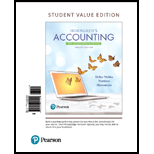
Concept explainers
Predetermined
The Predetermined Overhead allocation rate is used to allocate the manufacturing overhead over the jobs. Predetermined Overhead allocation rate is calculated by dividing the Total Estimated overhead cost by the Total Estimated allocation base.
The formula to calculate the Predetermined Overhead allocation rate is as follows:
1. Total Indirect Cost
To determine: The Indirect cost in total and per unit allocated on the basis of single plant wide overhead allocation rate.
2. Predetermined Overhead allocation rate:
To determine: The Predetermined Overhead allocation rate for each activity
3. Activity based cost per unit:
To determine: The Activity based cost per unit for each product using the Predetermined Overhead allocation rate for each activity
4. Comparison Activity based cost per unit:
To show: The comparison Activity based cost per unit under both methods:
Want to see the full answer?
Check out a sample textbook solution
Chapter 24 Solutions
Horngren's Accounting: The Managerial Chapters, Student Value Edition (12th Edition)
- You are a financial analyst at Beta Ltd., a company that is considering acquiring Alpha Ltd. You have been tasked to perform a discounted cash flow (DCF) valuation analysis in Excel to determine the value of the target company and advise on whether the acquisition would be financially beneficial. The following information is provided: 1. Alpha Ltd. revenues were Sh.12.5 million. This revenue is expected to grow at a constant annual growth rate of 7.5% over the next 5 years. 2. Alpha’s Ltd. gross profit margin is 75%. 3. The target company currently has Sh.8 million in debt and Sh. 3 million in equity. 4. Selling general, administration and other expenses is expected to be 45% of sales. 5. Depreciation is expected to be 2.5% of sales. 6. Net capital expenditures are expected to be 2.5% of net revenue annually. 7. Changes in net working capital are expected to amount to Sh.500,000, Sh.600,000, Sh.700,000,…arrow_forwardHanks Company estimates its manufacturing overhead to be $450,000 and its direct labor costs to be $300,000 for year 5. Hanks worked three jobs for the year. Job 5-1, which was sold during year 5, had actual direct labor costs of $90,000. Job 5-2, which was completed but not sold at the end of the year, had actual direct labor costs of $140,000. Job 5-3, which is still in work-in-process inventory, had actual direct labor costs of $80,000. The actual manufacturing overhead for year 5 was $470,000. Manufacturing overhead is applied on the basis of direct labor costs. a) How much overhead was applied to each job in year 5? b) What was the over-or underapplied manufacturing overhead for year 5?arrow_forwardGiven solution for General accounting question not use aiarrow_forward
- I need assistance with this financial accounting question using appropriate principles.arrow_forwardMing Sporting Goods had a balance in the Accounts Receivable account of $780,000 at the beginning of the year and a balance of $820,000 at the end of the year. Net credit sales during the year amounted to $6,400,000. Required: What was the average collection period of the receivables in terms of days?arrow_forwardA company produces a single product. Variable production costs are $18.2 per unit, and variable selling and administrative expenses are $6.5 per unit. Fixed manufacturing overhead totals $72,000, and fixed selling and administration expenses total $63,000. Assuming a beginning inventory of zero, production of 7,500 units, and sales of 5,200 units, the dollar value of the ending inventory under variable costing would be_.arrow_forward

 AccountingAccountingISBN:9781337272094Author:WARREN, Carl S., Reeve, James M., Duchac, Jonathan E.Publisher:Cengage Learning,
AccountingAccountingISBN:9781337272094Author:WARREN, Carl S., Reeve, James M., Duchac, Jonathan E.Publisher:Cengage Learning, Accounting Information SystemsAccountingISBN:9781337619202Author:Hall, James A.Publisher:Cengage Learning,
Accounting Information SystemsAccountingISBN:9781337619202Author:Hall, James A.Publisher:Cengage Learning, Horngren's Cost Accounting: A Managerial Emphasis...AccountingISBN:9780134475585Author:Srikant M. Datar, Madhav V. RajanPublisher:PEARSON
Horngren's Cost Accounting: A Managerial Emphasis...AccountingISBN:9780134475585Author:Srikant M. Datar, Madhav V. RajanPublisher:PEARSON Intermediate AccountingAccountingISBN:9781259722660Author:J. David Spiceland, Mark W. Nelson, Wayne M ThomasPublisher:McGraw-Hill Education
Intermediate AccountingAccountingISBN:9781259722660Author:J. David Spiceland, Mark W. Nelson, Wayne M ThomasPublisher:McGraw-Hill Education Financial and Managerial AccountingAccountingISBN:9781259726705Author:John J Wild, Ken W. Shaw, Barbara Chiappetta Fundamental Accounting PrinciplesPublisher:McGraw-Hill Education
Financial and Managerial AccountingAccountingISBN:9781259726705Author:John J Wild, Ken W. Shaw, Barbara Chiappetta Fundamental Accounting PrinciplesPublisher:McGraw-Hill Education





